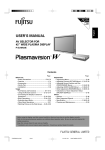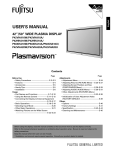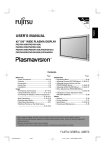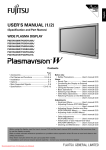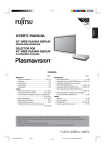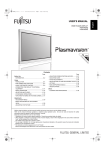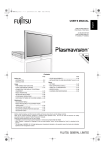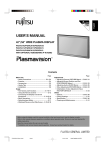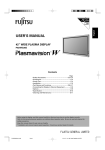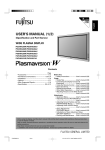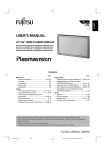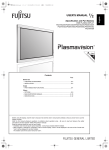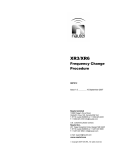Download USER`S MANUAL - fujitsu general
Transcript
English USER’S MANUAL 42”/50” WIDE PLASMA DISPLAY FOR FUJITSU 42” WIDE (MODEL: P42VHA10E/P42HHA10E/P42VHA20E) WITH OPTIONAL VIDEOBOARD (P-TE1000E/P-TE1010E). FOR FUJITSU 50” WIDE (MODEL: P50XHA10E) WITH OPTIONAL VIDEOBOARD (P-TE1000E/P-TE1010E). Contents Page Before Use • Safety Precautions ··································· E-2–E-3 • Features ····························································E-4 • Accessories ······················································ E-5 • Handy Tips ······················································· E-5 • Installation ······················································· E-6 Usage • Part Names and Functions ···················· E-7–E-10 • Using the Remote Control ··················· E-11–E-12 • Connecting the Display to External Equipment ············································ E-13–E-18 • Basic Operations ············································ E-19 • Selecting Input Mode ····································· E-20 • Other Basic Operations ································· E-21 • Watching Pictures on the Wide Screen ··· E-22–E-23 * Page Adjustments • Adjustment Menu ········································· E-24 • Adjusting Pictures (PICTURE Menu) ··· E-25–E-27 • Adjusting Screen Position and Size (POSITION/SIZE Menu) ························ E-28–E-29 • Adjusting AUDIO (AUDIO Menu) ········ E-30–E-31 • Other Adjustments (FEATURES Menu) ··· E-32–E-40 • Initialization of User Adjustment Value (FACTORY DEFAULT) ·····································E-41 Others • Options ·················································· E-42–E-43 • Factory Settings ············································ E-44 • Specification ········································· E-45–E-46 • Cleaning and Maintenance ····························E-47 is a worldwide trademark of Fujitsu General Limited and is a registered trademark in Japan, the U.S.A. and other countries or areas. Please Note: Video functionality is only available if the plasma screen has the optional videoboard P-TE1000E or P-TE1010E fitted. Before using the display, read this manual carefully so that you know how to use the display correctly. Refer to this manual whenever questions or problems about operation arise. Be sure to read and observe the safety precautions. Keep this manual where the user can see it easily. * Installation and removal require special expertise. Consult your product dealer for details. E-P42VHA10E-OV(hyo1) Page 2 03.1.16, 12:12 Adobe PageMaker 6.5J/PPC SAFETY PRECAUTIONS IMPORTANT INFORMATION IMPORTANT The lightning flash with arrowhead symbol, within an equilateral triangle, is intended to alert the user to the presence of uninsulated “dangerous voltage” within the product’s enclosure that may be of sufficient magnitude to constitute a risk of electric shock to persons. CAUTION: TO PREVENT THE RISK OF ELECTRIC SHOCK, DO NOT REMOVE COVER (OR BACK). NO USER-SERVICEABLE PARTS INSIDE. REFER SERVICING TO QUALIFIED SERVICE PERSONNEL. The exclamation point within an equilateral triangle is intended to alert the user to the presence of important operating and maintenance (servicing) instructions in the literature accompanying the appliance. WARNING: This is a Class B product. In a domestic environment this product may cause radio interference in which case the user may be required to take adequate measures. WARNING: TO REDUCE THE RISK OF FIRE AND ELECTRIC SHOCK, DO NOT EXPOSE THIS PRODUCT TO RAIN OR MOISTURE. FCC NOTICE • P42VHA10E/P42HHA10E/P50XHA10E/P42VHA20E with optional Videoboard (P-TE1000E/P-TE1010E): A Class B digital device This equipment has been tested and found to comply with the limits for a Class B digital device, pursuant to Part 15 of the FCC Rules. These limits are designed to provide reasonable protection against harmful interference in a residential installation. This equipment generates, uses and can radiate radio frequency energy and, if not installed and used in accordance with the instructions, may cause harmful interference to radio communications. However, there is no guarantee that interference will not occur in a particular installation. If this equipment does cause harmful interference to radio or television reception, which can be determined by turning the equipment off and on, the user is encouraged to try to correct the interference by one or more of the following measures: – Reorient or relocate the receiving antenna. – Increase the separation between the equipment and receiver. – Connect the equipment into an outlet on a circuit different from that to which the receiver is connected. – Consult the dealer or an experienced radio/TV technician for help. IMPORTANT SAFETY INSTRUCTIONS Electrical energy can perform many useful functions. This unit has been engineered and manufactured to assure your personal safety. But IMPROPER USE CAN RESULT IN POTENTIAL ELECTRICAL SHOCK OR FIRE HAZARD. In order not to defeat the safeguards incorporated into this product, observe the following basic rules for its installation, use and service. Please read these “Important Safeguards” carefully before use. 1) Read these instructions. 2) Keep these instructions. 3) Heed all warnings. 4) Follow all instructions. 5) Do not use this apparatus near water. 6) Clean only with dry cloth. 7) Do not block any ventilation openings. Install in accordance with the manufacturer’s instructions. 8) Do not install near any heat sources such as radiators, heat registers, stoves, or other apparatus (including amplifier’s) that produce heat. 9) Do not defeat the safety purpose of the polarized or grounding-type plug. A polarized plug has two blades with one wider than the other. A grounding type plug has two blades and a third grounding prong. The wide blade or the third prong are provided for your safety. If the provided plug does not fit into your outlet, consult an electrician for replacement of the obsolete outlet. 10) Protect the power cord from being walked on or pinched particularly at plugs, convenience receptacles, and the point where they exit from the apparatus. 11) Only use attachments/accessories specified by the manufacturer. 12) Use only with the cart, stand, tripod, bracket, or table specified by the manufacturer, or sold with the apparatus. When a cart is used, use caution when moving the cart/apparatus combination to avoid injury from tip-over. 13) Unplug this apparatus during lightning storms or when unused for long periods of time. E-2 E-P42VHA10E-OV(02̲06) Page 2 03.1.16, 11:27 Adobe PageMaker 6.5J/PPC – Unplug this product from the wall outlet before cleaning. Do not use liquid cleaners or aerosol cleaners. Use a damp cloth for cleaning. – Do not use attachments not recommended by the product manufacturer as they may cause hazards. – Do not use immediately after moving from a low temperature to high temperature, as this causes condensation, which may result in fire, electric shock, or other hazards. – The apparatus shall not be exposed to dripping or splashing. – No objects filled with liquids, such as vases, shall be placed on the apparatus. – Do not place this product on an unstable cart, stand, or table. The product may fall, causing serious injury to a child or adult, and serious damage to the product. The product should be mounted according to the manufacturer’s instructions, and should use a mount recommended by the manufacturer. – When the product is used on a cart, care should be taken to avoid quick stops, excessive force, and uneven surfaces which may cause the product and cart to overturn, damaging equipment or causing possible injury to the operator. – Slots and openings in the cabinet are provided for ventilation. These ensure reliable operation of the product and protect it from overheating. These openings must not be blocked or covered. (The openings should never be blocked by placing the product on bed, sofa, rug, or other similar surface. It should not be placed in a built-in installation such as a bookcase or rack unless proper ventilation is provided and the manufacturer’s instructions have been adhered to.) For proper ventilation, separate the product from other equipment, which may prevent ventilation, and keep distance more than 10 cm. – This product should be operated only from the type of power source indicated on the label. If you are not sure of the type of power supply of your home, consult your product dealer or local power company. – This product is equipped with a three-wire plug. This plug will fit only into a grounded power outlet. If you are unable to insert the plug into the outlet, contact your electrician to install the proper outlet. Do not defeat the safety purpose of the grounded plug. – Power-supply cords should be routed so that they are not likely to be walked on or pinched by items placed upon or against them. Pay particular attention to cords at doors, plugs, receptacles, and the point where they exit from the product. – For added protection for this product during a lightning storm, or when it is left unattended and unused for long periods of time, unplug it from the wall outlet and disconnect the cable system. This will prevent damage to the product due to lightning and power line surges. – Do not overload wall outlets, extension cords, or convenience receptacles on other equipment as this can result in a risk of fire or electric shock. – Never push objects of any kind into this product through openings as they may touch dangerous voltage points or short out parts that could result in a fire or electric shock. Never spill liquid of any kind on the product. – Do not attempt to service this product yourself as opening or removing covers may expose you to dangerous voltages and other hazards. Refer all service to qualified service personnel. – Unplug this product from the wall outlet and refer service to qualified service personnel if the product does not operate normally by following the operating instructions. Adjust only those controls that are covered by the Operation Manual, as an improper adjustment of other controls may result in damage and will often require extensive work by a qualified technician to restore the product to its normal operation. – When replacement parts are required, be sure the service technician has used replacement parts specified by the manufacturer or with same characteristics as the original part. Unauthorized substitutions may result in fire, electric shock, or other hazards. – Upon completion of any service or repairs to this product, ask the service technician to perform safety checks to determine that the product is in proper operating condition. – The product should be placed more than one foot away from heat sources such as radiators, heat registers, stoves, and other products (including amplifiers) that produce heat. – When connecting other products such as VCR’s, and personal computers, you should turn off the power of this product for protection against electric shock. – Do not place combustibles behind the cooling fan. For example, cloth, paper, matches, aerosol cans or gas lighters that present special hazards when overheated. – Use only the accessory cord designed for this product to prevent shock. The power supply voltage rating of this product is AC110–240 V (42”) and AC220–240 V (50”), and the power cord attached conforms to the following power supply voltage. Use only the power cord designated by our dealer to ensure Safety and EMC. When it is used with other power supply voltage, the power cable must be changed. Use the standard power plug and cord set of the specified country. Power cord Consult your product dealer. Power supply voltage: AC 100–125 V (Not included) AC 200–240 V (Included) AC 240 V (SAA TYPE) (Not included) E-3 E-P42VHA10E-OV(02̲06) Page 3 03.1.16, 11:27 Adobe PageMaker 6.5J/PPC English 14) Refer all servicing to qualified service personnel. Servicing is required when the apparatus has been damaged in any way, such as powersupply cord or plug is damaged, liquid has been spilled or objects have fallen into the apparatus, the apparatus has been exposed to rain or moisture, dose not operate normally, or has been dropped. FEATURES Variety of input signals • In addition to mD-sub terminal, the display also supports input of digital RGB signal input enabling DVI standard (HDCP*) high definition picture quality. • Depending on the model, the display supports video input for different colour television systems as follows: NTSC, PAL, SECAM, PAL60, N-PAL, M-PAL, 4.43NTSC. Desired screen size • This display offers a total of five different screen sizes in video input mode: Normal, Wide1, Wide2, Zoom1, and Zoom2. A Normal mode is also available for displaying of normal-size (4:3 aspect ratio) pictures. • The display has a Compose mode to switch screen size automatically depending on the contents of software. • Three different screen sizes in RGB input mode (Normal, Wide, and Zoom) are also available. Picture quality • Pro-setting allows adjustment for even higher picture quality. • Noise reduction function reduces noise to ensure clear pictures. • A display suitable for such film materials as movie pictures can be made by 24 frame mode function. Convenient power saving setting • When no video signal is input to the display or the remote control is not operated for a long time, this function automatically reduces the power consumption of the unit. Others • The white screen and screen orbiter functions are available to minimize phosphor burn-in. • 3 audio input terminals and 20 W + 20 W (42”)/12 W + 12 W (50”) external speaker output terminal are available. * The HDCP (High-bandwidth Digital Content Protection) function ensures that high-vision digital contents (movies, etc.) provided with copy-guard protection can be displayed on the plasma display. E-4 E-P42VHA10E-OV(02̲06) Page 4 03.1.16, 11:27 Adobe PageMaker 6.5J/PPC CHECKING ACCESSORIES One remote control Two AA batteries One user’s manual One power cable Two big ferrite cores Two small ferrite cores Manual HANDY TIPS • Viewing the screen constantly for extended periods can strain your eyes. Be sure to stay at a proper distance (at least 1.5 m or 5 feet (42”)/1.9 m or 6.3 feet (50”)) from the screen and to look occasionally away while working. • Have the display inspected and cleaned by your dealer at regular intervals. • Pictures may become “burnt” into the screen phosphors if the screen is left on for extended periods. To ensure that the display has a prolonged service life, be sure to use a screen orbiter, white screen. This will ensure the same picture or pattern is not constantly displayed for long periods. (See P. E-39–E-40.) • The plasma display panel, which is built for maximum precision, provides more than 99.99% effective pixels. You may find, however, that some pixels constantly remain lit or dimmed. • The display has a fan to prevent its internal temperature from rising. • Be careful with the air delivered by the fan. It may be very hot. • Contact your dealer if you find that the display does not seem to function properly when used with other audio-visual equipment. You may need to move your display if it produces degraded pictures or noise due to electromagnetic radiation, or if the infrared remote control does not function properly. • Pictures may not be displayed properly if you connect a non-standard PC to the RGB input terminal. In this case, contact your dealer for more information. • The protective circuit, built into the display, automatically turns off the power if the display has a problem. In this case, you will see that the power indicator lamp flashes red. Warning If the power indicator lamp flashes red, this signifies that the display has developed a problem. When this happens, be sure to remove the power plug from the receptacle to prevent fire or electric shock. Then, check the display in accordance with the instructions given on P. E-47, or contact your dealer. Information Cables for connecting the display to external equipment are not supplied. Contact your dealer for more information on these products. E-5 E-P42VHA10E-OV(02̲06) Page 5 03.1.16, 11:27 Adobe PageMaker 6.5J/PPC English ACCESSORIES INSTALLATION To prevent the display’s internal components from overheating, make sure that the display is installed in a well-ventilated location. Be sure to use the optional stand, wall-mounting unit or the other unit when installing the display. Also, be also sure that your dealer performs the installation. See the appropriate instruction manual for more information on the installation hardware you select. To prevent an accident and ensure safety in the event of an earthquake, fix the display securely into position as described below. To ensure proper heat radiation, provide at least as much space around the display as shown below. * Make sure that the display is installed in a location where the temperature can be maintained between 0°C and 40°C. * Never attempt to tilt the display sideways or backward. * To prevent the power and other cables from being accidentally pulled, make sure that they run along the wall or through corners. * The display can be installed with either of its sides facing down. Side Front (cm) Upper (cm) 10 Left 10 10 Right Wall 5 Lower 4 Note The display is a highly precise piece of equipment and therefore must be packed properly before transportation. Be sure to use only those packing materials originally supplied with the display when repacking it. Reference See P. E-42 for more information on options. E-6 E-P42VHA10E-OV(02̲06) Page 6 03.1.16, 11:27 Adobe PageMaker 6.5J/PPC English PART NAMES AND FUNCTIONS DISPLAY SECTION – FRONT (Right section) 1 Power indicator lamp This lamp shows the state of the power supply. Lit (red): Stand-by Lit (green): Power ON Lit (orange): Power saving (DPMS: Power saving function) mode ON (See P. E-38.) Flashing (red): Malfunction (Flashes differently depending on the type of malfunction. See P. E-47 for more information.) 2 Remote control signal receiver Receives signals from the remote control. 3 Input mode selector button [MODE] 4 Input mode selector button [MODE] Switches between picture input modes. 5 VOL + button 6 VOL – button ① ② Adjusts the sound volume. ⑨ 7 Wide screen selector button [WIDE] Switches the screen over to a desired wide screen. 8 ON/OFF button Turns the power “ON” and “OFF (standby state)”. Control Panel (Right side of display) Warning If the power indicator lamp flashes red, this signifies that the display has developed a problem. When this happens, be sure to remove the power plug from the receptacle and contact your dealer. Leaving the display power ON can result in fire or electric shock. E-7 E-P42VHA10E-OV(07̲13) Page 7 03.1.16, 11:49 Adobe PageMaker 6.5J/PPC PART NAMES AND FUNCTIONS (Continued) DISPLAY SECTION – LOWER PART Bottom (P42VHA10 type) Bottom (P42HHA10 type) Bottom (50”) Bottom (P42VHA20 type) Videoboard P-TE1000E type 1 2 3 4 5 6 7 8 9 P-TE1010E type /I power switch When pressed while in the “OFF” state, the power indicator lamp lights and the display is placed in the “ON ” state, and the power can be turned “ON” or “OFF” by the remote control or on the control panel of the display. When pressed while in the “ON ” state, the power indicator lamp goes out and the display is placed in the “OFF” state where power is still partly supplied. RS-232C terminal (RS-232C) This terminal is provided for you to control the display from the PC. Connect it to the RS-232C terminal on the PC. When connecting a cable, attach a ferrite core to the cable. (See P. E-13.) RGB1 input terminal (RGB1 INPUT/DVI-D) Connect this terminal to the PC’s display (digital RGB) output terminal. *The connection cable No.88741-8000 made by molex Inc. is recommanded. RGB2 input terminal (RGB2 INPUT/mD-sub) Connect this terminal to the PC’s display (analog RGB) output terminal or decoder (digital broadcast tuner, etc.) output terminal. Power input terminal Connect this terminal to the power cable supplied with the display. When connecting a cable, attach a ferrite core to the cable. (See P. E-13.) External speaker output terminal (EXT SP) Connect this terminal to the optionally available speaker. When connecting a cable, attach a ferrite core to the cable. (See P. E-13.) *See the speaker instruction manual for more information. Audio3 input terminal (AUDIO3 INPUT) Audio2 input terminal (AUDIO2 INPUT) Audio1 input terminal (AUDIO1 INPUT) Connect this terminal to the sound output terminal of your VCR, etc. (See P.E-38 for the selection of audio input for video input.) E-8 E-P42VHA10E-OV(07̲13) Page 8 03.1.16, 11:49 Adobe PageMaker 6.5J/PPC English 0+A RGB3 input terminal (RGB3 INPUT/BNC) Connect this terminal to the PC's display (analog RGB) output terminal or decoder (digital broadcast tuner,etc.) output terminal. *When RGB3 input terminal is connected, Comp.video mode is not available. (See P. E-36.) A Component video input terminal (VIDEO4 INPUT) Connect this terminal to the component video output (colour difference output) terminal of your HDTV unit or DVD player. *When Comp.video input terminal is connected, RGB3 mode is not available. (See P. E-36.) B RGB3 synchronization switch (SYNC SW TTL/ANALOG (75 Ω)) This switch is used to terminate horizontal (H) terminal and vertical (V) terminal, out of RGB3 input terminals, with 75 Ω. TTL : Does not terminate. ANALOG (75 Ω): Terminates. C Video1 input terminal (VIDEO1 INPUT/P-TE1000E) Connect this terminal to the SCART terminal of your VCR or DVD, etc. *See “SETTING THE INPUT TERMINALS” on E-35. D S-Video input terminal (VIDEO2 INPUT/P-TE1010E) Connect this terminal to the S-video output terminal of your VCR. E Video input terminal (VIDEO1 INPUT/P-TE1010E) Connect this terminal to the video output terminal of your VCR. F Component video input terminal (VIDEO3 INPUT/P-TE1010E) Connect this terminal to the component video output (colour difference output) terminal of your HDTV unit or DVD player. Description of Input Terminals DVI-D terminal (RGB1 INPUT/DVI-D) RGB2 input terminal (RGB2 INPUT/mD-sub) SCART terminal 20 1816 1412 10 8 6 4 2 21 17 13 9 5 1 19 15 11 7 3 RS-232C terminal (RS-232C) Pin No. 1 2 3 4 5 6 7 8 Pin No. 1 2 3 4 5 6 7 Input signal Red Green Blue — Ground Ground Ground Ground Pin No. 9 10 11 12 13 14 15 Frame Input Signal Pin No. — 8 Right audio 9 — 10 Audio ground 11 Blue ground 12 Left audio 13 Blue 14 Pin No. 1 2 3 4 5 6 7 8 9 Input signal — Ground — — Horizontal synchronization Vertical synchronization — Ground Input Signal Pin No. — 15 Green ground 16 — 17 Green 18 — 19 Red ground 20 — 21 Input Signal Red/chrominance — — Composite video ground — Composite video/Y Ground Signal DCD (Data Carrier Detect) RD (Received Data) TD (Transmit Data) DTR (Data Terminal ready) GND (Ground) DSR (Data Set Ready) RTS (Request To send) CTS (Clear To Send) RI (Ring Indication) E-9 E-P42VHA10E-OV(07̲13) Page 9 03.1.16, 11:49 Adobe PageMaker 6.5J/PPC PART NAMES AND FUNCTIONS (Continued) REMOTE CONTROL For details, see page 1 . 2 MUTE button button Switches between power ON and standby state. 3 DISPLAY OFF button Temporarily mutes the sound. 5 PICTURE MEMORY button Recalls the PICTURE MEMORY. For showing on-screen-information. 4 PICTURE MODE button 6 WIDE button Switches the screen over to a desired wide screen. Switches the picture mode. 7 RGB input mode selector button [RGB 1 – 3] Selects RGB 1 – 3. 8 RGB3/VIDEO4 input mode selector button [RGB3/VIDEO4] Selects RGB3 or VIDEO4. 9 Video input mode selector button [VIDEO 1 – 3] Selects VIDEO 1 – 3. A Menu button [MENU] – Use this button to display a desired menu for adjusting the picture. B Enter button [ENTER] – Press this button to finalize the selection of a desired menu or option within a menu. 0 Volume adjustment buttons [VOL +/– ] Adjust the volume. Press the + button to increase the volume. Press the – button to reduce the volume. C Adjustment buttons [ – / Page 10 / ] Use these buttons to scroll through options in a menu. E-10 E-P42VHA10E-OV(07̲13) / 03.1.16, 11:49 Adobe PageMaker 6.5J/PPC English USING THE REMOTE CONTROL PUTTING BATTERIES IN THE REMOTE CONTROL 1 To remove the cover, slide it outwards while pressing it down. 2 Place two AA batteries in the remote control. Make sure that the batteries are properly oriented. 3 Close the cover until it snaps into place. PRECAUTIONS To prevent malfunction, be sure not to apply any form of severe shock to the remote control. To prevent malfunction or deformation, be sure not to allow the remote control to become wet; also, keep it away from hot locations or heating equipment. Be sure not to clean the remote control using a cloth dampened in any volatile solvent, such as benzene or thinner. CAUTION: Be sure to use replacement batteries of the same type as the original ones. When disposing of used batteries, please comply with governmental regulations or environmental public institution’s rules that apply in your country/area. Note The remote control will not function properly if the batteries are dead. Be sure to replace them as needed. Do not use rechargeable batteries (Ni-Cd). E-11 E-P42VHA10E-OV(07̲13) Page 11 03.1.16, 11:49 Adobe PageMaker 6.5J/PPC USING THE REMOTE CONTROL (Continued) EFFECTIVE RANGE FOR THE REMOTE CONTROL Point the remote control at the display’s signal receiver when using it. Make sure that there are no obstacles between the remote control and the display’s signal receiver. Upper 20° 20° Lower Display – side Left 30° 30° Right 5 m (Front) Display – front Information The remote control may not function properly if you use a high-frequency fluorescent lamp. If you experience problems, move the lamp or use the remote control from a different position. E-12 E-P42VHA10E-OV(07̲13) Page 12 03.1.16, 11:49 Adobe PageMaker 6.5J/PPC Be sure to turn OFF the power to the display and external equipment before making any connections. No cables are supplied with the display for connection to external equipment. The type of cable to be used varies depending on the PC model. Contact your dealer for more information. RECEPTACLE Make sure that the power cable’s grounding wire is grounded. The display comes with a 3-prong power plug; one prong is connected to the grounding wire. If you have only a 2-hole receptacle, you will need to have it replaced. Contact your dealer for more information. CONNECTING THE DISPLAY TO EXTERNAL EQUIPMENT Carefully check the terminals for position and type before making any connections. Loose connectors can result in picture or colour problems. Make sure that all connectors are securely inserted into their terminals. Ferrite cores These ferrite cores are used to attenuate undesired signals. Two big ferrite cores When connecting a cable to the power input terminal, RS-232C terminal, attach one of these ferrite cores to the cable near the terminal. Power Cable RS-232C Cable Ferrite Core Ferrite Core Two small ferrite cores When connecting a cable to the external speaker output terminal attach one of these ferrite cores to the cable near the terminal. Ferrite Core Ferrite Core E-13 E-P42VHA10E-OV(07̲13) Page 13 03.1.16, 11:49 Adobe PageMaker 6.5J/PPC English CONNECTING THE DISPLAY TO EXTERNAL EQUIPMENT CONNECTING THE DISPLAY TO EXTERNAL EQUIPMENT (Continued) EXAMPLE OF CONNECTION TO EXTERNAL COMPONENTS Speaker Speaker (optional) Display Remote control VCR or other external components See P. VCR E-15 Satellite tuner E-17 PC E-18 DVD player E-14 E-P42VHA10E-OV(14̲18) Page 14 03.1.16, 11:50 Adobe PageMaker 6.5J/PPC English VCR • Connect the video signal cable to the SCART terminal. (When the P-TE1000E is installed.) • Connect the video signal to either the S-video input terminal or the video input terminal. (When the P-TE1010E is installed.) To SCART output To SCART input An example of the underside of the display (with the P-TE1000E installed in the P42VHA10) To video output To S-video output To audio output To audio input To S-video input To video input An example of the underside of the display (with the P-TE1010E installed in the P42VHA10) Note • Unplug the power cord from the AC outlet before you connect external components. • Also refer to the instructions for the component to be connected. • When inputting audio, connect to the terminals corresponding to the used video input or RGB input. E-15 E-P42VHA10E-OV(14̲18) Page 15 03.1.16, 11:50 Adobe PageMaker 6.5J/PPC CONNECTING THE DISPLAY TO EXTERNAL EQUIPMENT (Continued) DVD PLAYER • Connect the video signal cable to either the component video terminal or the SCART terminal. (When the P-TE1000E is installed.) • Connect the video signal cable to the component video input terminal, S-video input terminal, or the video input terminal. (When the PTE1010E is installed.) • If the component to be connected is equipped with component video output terminal, it is recommended to connect to the component video terminal. To SCART output To component video output To audio output To component video input To SCART input To audio input An example of the underside of the display (with the P-TE1000E installed in the P42VHA10) To component video output To video input To video output To S-video output To audio output To audio input To component video input To S-video input An example of the underside of the display (with the P-TE1010E installed in the P42VHA10) E-16 E-P42VHA10E-OV(14̲18) Page 16 03.1.16, 11:50 Adobe PageMaker 6.5J/PPC • Connect the video signal cable to either the component video terminal or the SCART terminal. (When the P-TE1000E is installed.) • Connect the video signal cable to the component video input terminal, S-video input terminal, or the video input terminal. (When the PTE1010E is installed.) • If the component to be connected is equipped with component video output terminal, it is recommended to connect to the component video terminal. To SCART output To component video output To audio output To component video input To SCART input To audio input An example of the underside of the display (with the P-TE1000E installed in the P42VHA10) To component video output To video input To video output To S-video output To audio output To audio input To component video input To S-video input An example of the underside of the display (with the P-TE1010E installed in the P42VHA10) Note • Unplug the power cord from the AC outlet before you connect external components. • Also refer to the instructions for the component to be connected. • When inputting audio, connect to the terminals corresponding to the used video input or RGB input. E-17 E-P42VHA10E-OV(14̲18) Page 17 03.1.16, 11:50 Adobe PageMaker 6.5J/PPC English SATELLITE TUNER CONNECTING THE DISPLAY TO EXTERNAL EQUIPMENT (Continued) PC • As the cable for connecting a PC differs with the PC model, please consult your dealer for information on the right cable to purchase. • The PC can be connected to either the front side or the rear side, whichever is most convenient. To RGB output (DVI-D) To RGB output (mD-sub) To RGB2 input (mD-sub) To audio output To audio input To RGB1 input (DVI-D) An example of the underside of the display (with the P-TE1000E installed in the P42VHA10) Note • Unplug the power cord from the AC outlet before you connect external components. • Also refer to the instructions for the component to be connected. • When inputting audio, connect to the terminals corresponding to the used video input or RGB input. E-18 E-P42VHA10E-OV(14̲18) Page 18 03.1.16, 11:50 Adobe PageMaker 6.5J/PPC English BASIC OPERATIONS TURNING THE POWER ON AND OFF 1 Press /I to the left at the bottom of the display. The power lamp lights up. 2 Press 3 Press on the remote control. The colour of the power lamp changes from “Red” to “Green”. – or – or . Select the video mode to be input. Press when the power is ON. The colour of the power lamp changes from “Green” to “Red” and the power turns “OFF”. * You can also use the buttons on the display’s control panel to perform these steps. ADJUSTING THE VOLUME Press the Volume button Press to increase the volume. Press to reduce the volume. Any value between 0 and 40 can be selected. * Note that the volume level remains stored even when you turn OFF the power. When the volume adjustment button is pressed Muting the sound Press . The sound is removed. Press again to restore the sound to the original level. The mute mode can also be released by pressing the volume buttons. E-19 E-P42VHA10E-OV(19̲24) Page 19 03.1.16, 11:52 Adobe PageMaker 6.5J/PPC SELECTING INPUT MODE VIDEO INPUT MODE 1 Press the – buttons to select the input mode. You can select from VIDEO1 mode to VIDEO4 mode. The video modes corresponding to each input terminal are as follows. • VIDEO1: SCART (when P-TE1000E is installed), Video (when P-TE1010E is installed) Video1 mode • VIDEO2: S-Video (when P-TE1010E is installed) • VIDEO3: Comp. video (when P-TE1010E is installed) • VIDEO4: Comp. video * For selection of the input terminal, see “SETTING THE INPUT TERMINALS” on P. E-36. * You can select between RGB3 and VIDEO4 in INPUT TERMINALS. * You can also use the buttons on the display’s control panel to perform these steps. RGB INPUT MODE 1 Press – input mode. to select the You can select between the modes from RGB1 to RGB3. The input terminal of each RGB mode is as follows. • RGB1: DVI-D RGB1 mode • RGB2: mD-sub • RGB3: BNC E-20 E-P42VHA10E-OV(19̲24) Page 20 03.1.16, 11:52 Adobe PageMaker 6.5J/PPC English OTHER BASIC OPERATIONS CONVENIENT FUNCTIONS On-screen information (DISPLAY) Press . The mode is indicated on the screen for 5 seconds. Picture Mode (PICTURE MODE) Press . This button can be used to switch the picture mode. In the picture mode, you can switch between the set status and the fine mode. * For the picture mode settings, see “Setting Picture Mode (P. E-26)”. Picture Memory (PICTURE MEMORY) Press . This button can be used to recall the settings of the picture memories 1 – 8. Each time this button is pressed, the setting changes as follows. E-21 E-P42VHA10E-OV(19̲24) Page 21 03.1.16, 11:52 Adobe PageMaker 6.5J/PPC WATCHING PICTURES ON THE WIDE SCREEN SWITCHING BETWEEN SCREEN SIZES 1 Press 2 Press to select a desired picture mode. . The currently selected mode will appear. Each time you press , a different picture mode appears. The sequences used are as follows: Normal mode When you are in a Video or S-video input mode When you are in a Comp.video input mode When you are in an RGB input mode Wide1 mode * You can also use the buttons on the display’s control panel to perform these steps. * Depending on the type of signal, some aspects may not be selected. Note • Displaying a picture in a Normal mode for extended periods of time may cause phosphor burn-in. • A variety of picture modes are available with this display. Remember that if you select a mode with an aspect ratio (ratio of frame width to frame height) different from that of the TV program or video media, the pictures will appear differently than if you had selected a mode having the same aspect ratio. • Showing a movie or similar premium event at a different aspect ratio from its original one at any event site, restaurant, or bar for profit-making purposes or for a public audience may constitute a copyright infringement. For films, try to select a mode having the same aspect ratio as the original picture; this enables the director’s original intentions to be preserved. Reference See P. E-28–E-29 for how to adjust the picture size and position. E-22 E-P42VHA10E-OV(19̲24) Page 22 03.1.16, 11:52 Adobe PageMaker 6.5J/PPC English SCREEN SIZE Normal Displays pictures of normal size (i.e., a 4:3 aspect ratio). Compose The screen size changes automatically in accordance with the contents of image software you use. Wide1 Displays natural-looking pictures of standard size on the wide screen. Picture of standard size Wide1 Vertically extended picture Wide2 Horizontally extended picture Zoom1 Horizontally extended picture with caption Zoom2 Wide2/Wide Ideal for displaying vertically extended pictures such as squeezed pictures and recorded HDTV programs. Zoom1/Zoom Enlarges horizontally extended pictures equally in all directions to maintain the aspect ratio constant. Zoom2 Reduces the height of horizontally extended pictures with captions, without eliminating the caption. Only the height of pictures is reduced, not the height of the caption. (Captions may not be easy to read, however, depending on the picture.) ASPECT RATIO The following aspect ratios are available. 4:3 aspect ratio (VHF/UHF broadcasting, BS broadcasting) 4 16:9 aspect ratio (HDTV broadcasting) 16 3 9 1.85 1.85:1 aspect ratio (Vista Vision size) 2.35 2.35:1 aspect ratio (Cinema Vision size) 1 1 Information You may find dark areas on top and at the bottom of the screen if you select one of the Zoom modes for media while using the Vista Vision or Cinema Vision size i.e., the sizes used frequently for picture software. E-23 E-P42VHA10E-OV(19̲24) Page 23 03.1.16, 11:52 Adobe PageMaker 6.5J/PPC ADJUSTMENT MENU ADJUSTMENT MENU MENU PICTURE Contrast POSITION/SIZE Brightness AUDIO Colour FEATURES Tint FACTORY DEFAULT Sharpness Picture Mode PrecisionSetting Luminance Noise Reduction * Black Level Picture Memory Colour Temp. Position Size Can be set when Fine is selected as the Picture Mode. User Colour Temp. *: for other than RGB Treble Bass Balance Loudness Adjustment Dot Clock for RGB2, RGB3 Function Clock Phase for RGB2, RGB3 On Screen Menu Clamp Position for RGB2, RGB3, Comp. video Input Terminal Auto Calibration for RGB2, RGB3 24 Frame Mode for Video Others OSD Language Name Select with P-TE1000E with P-TE1010E Video Input Video Input BNC Input S-video Input D-SUB Input BNC Input DVI Input D-SUB Input DVI Input DPMS for other than RGB1 Audio Input Screen Orbiter for RGB Direct Setting for RGB Code Setting for RGB2, RGB3 White Screen Exhibition Mode Information E-24 E-P42VHA10E-OV(19̲24) Page 24 03.1.16, 11:52 Adobe PageMaker 6.5J/PPC English ADJUSTING PICTURES (PICTURE MENU) BASIC OPERATIONS [EX.: ADJUSTING TINT (Tint)] You can make changes to all picture adjustment options in the PICTURE Menu. The changes you make will be stored for a selected input mode. Therefore, you need to select a desired input mode before making any changes. 1 Press 2 Press . The main menu screen will appear. or to select “PICTURE”. Each time you press or , one of the available menus appears in the following sequence: PICTURE POSITION/SIZE AUDIO “PICTURE” selected in the main menu screen (Video Input Mode) FEATURES FACTORY DEFAULT The PICTURE Menu screen will appear. 3 Press “Tint”. 4 Press or to select . The “Tint” adjustment screen will appear. “Tint” selected in the PICTURE Menu screen (Video Input Mode) 5 Press or to change tint values. : More greenish colours : More purplish colours 6 Press to store. Press when you finish. “Tint” adjustment screen * Repeat steps 3, 4, 5 and 6 when you wish to make changes to other options. * When is pressed after you have selected “Default”, the settings are returned to those that were valid when you purchased the set. * On-screen information disappears if you do not take any action for about 60 seconds. E-25 E-P42VHA10E-OV(25̲31) Page 25 03.1.16, 11:53 Adobe PageMaker 6.5J/PPC ADJUSTING PICTURES (PICTURE MENU) (Continued) • Contrast, brightness, colour darkness, tint, and picture sharpness are adjusted as shown in the following chart. Select the item with , and then adjust with . Finally, press to implement the adjustments. Adjustment Item Adjustment Range/Remarks Contrast Lower contrast Higher contrast –30 to +30 Brightness Darker screen Brighter screen –60 to +60 Colour Lighter colours Darker colours –60 to +60 Tint More purplish colours More greenish colours –60 to +60 (RGB, Comp. video) –30 to +30 (Video, S-video) Sharpness Softer pictures Sharper pictures –4 to +4 (RGB) –16 to +16 (other than RGB) • Setting Picture Mode (Picture Mode) Can set up the picture mode. Each time you press or , one of the available choices appears in the following sequence: Dinamic: Suitable for watching a normal motion picture. (Standard) Fine: Suitable for watching a dark picture such as movie. Real 1: Makes a strong contrast picture. Real 2: Makes a bright colour picture. Static: Suitable for watching a still picture. Press to store. *Select Dinamic, Fine, Real 1, Real 2 or Static to suit your taste. • Precision Setting (for more advanced adjustment) Luminance, Black Level, Colour Temperature, and User Colour Temperature are adjusted as shown in the following chart. Select the item with adjustments. , and then adjust with Adjustment Item . Finally, press to implement the Contents of Adjustments Operation Adjustment Range/Remarks Luminance Adjusts the luminance level. (when the Picture Mode is Fine) Use to adjust. 40 to 100% Black Level Adjusts the picture when watching a dark image. (when the Picture Mode is Fine) Use to adjust. –15 to +15 Colour Temperature Set to low to obtain a warm atmosphere, and set to high to obtain a cold atmosphere. Use to adjust. –3500 to +3500 User Colour Temperature Enables individual adjustment of Red, Green and Blue. Use adjust. to select, and use to 0 to 255 E-26 E-P42VHA10E-OV(25̲31) Page 26 03.1.16, 11:54 Adobe PageMaker 6.5J/PPC English • Setting Noise Reduction (Noise Reduction) Can select the noise reduction setting corresponding to the noise level of the input signal. Each time you press or ,one of the available choices appears in the following sequence: Off: Noise reduction does not function. Min.: Weak setting Std.: Standard setting Max.: Strong setting Press to store. * Some type of signal can not be selected. • Storing the setting of PICTURE (Picture Memory) Stores 8 patterns of adjustments set by PICTURE. Read out and store to suit your taste. In case of “Load” When setting “Load”: Read out your desired Setting. (1) Select “Picture Memory” and press . The “Picture Memory” screen will appear. (2) Press or “Picture Memory” selection screen to select Load. (3) Select Data number to make Load. (4) Press to read out. In case of “Save” When setting “Save”: Set to suit your taste and store. (1) Select “Picture Memory” and press . The “Picture Memory” screen will appear. (2) Press or to select Save. “Load” selection screen (3) Select Data number to make Save. (4) Press to save. * On-screen information disappears if you do not take any action for about 60 seconds. E-27 E-P42VHA10E-OV(25̲31) Page 27 03.1.16, 11:54 Adobe PageMaker 6.5J/PPC ADJUSTING SCREEN POSITION AND SIZE (POSITION/SIZE MENU) BASIC OPERATION [EX.: ADJUSTING HORIZONTAL DIRECTION OF SCREEN POSITION] You can make changes to all screen adjustment options in the POSITION/SIZE Menu. The changes you make will be stored for the selected input mode. Therefore, you need to select a desired input mode before making any changes. 1 Press 2 Press . The main menu screen will appear. or to select “POSITION/SIZE”. Each time you press or , one of the available menus appears in the following sequence: PICTURE POSITION/SIZE AUDIO “POSITION/SIZE” selected from the main menu screen FEATURES FACTORY DEFAULT The POSITION/SIZE Menu screen will appear. 3 4 5 Press or “Position”. Press to select . The “Position” adjustment screen will appear. Press , , or to change position values. : Moves screen up. : Moves screen down. 6 : Moves screen to the right. : Moves screen to the left. Press to store. Press when you finish. “Position” adjustment screen * Repeat steps 3 to 6 when you wish to make changes to other options. * When is pressed after you have selected “Default”, the settings are returned to those that were valid when you purchased the set. E-28 E-P42VHA10E-OV(25̲31) Page 28 03.1.16, 11:54 Adobe PageMaker 6.5J/PPC English Adjusting Screen Position (Position) Horizontal position (Horizontal) : Moves screen to the right. : Moves screen to the left. → → “Position” adjustment screen Vertical position (Vertical) : Moves screen up. → : Moves screen down. → Press to store. Adjusting Screen Size (Size) Screen width (Width) : Increases width. → : Reduces width. → “Size” adjustment screen Screen height (Height) Press : Increases height. → : Reduces height. → to store. *You cannot adjust screen size in RGB1 (DVI-D) mode. Setting Range Video, S-video mode Comp.video mode RGB mode Position Horizontal: -30 to +30 Vertical Zoom: -15 to +15 Others: -7 to +7 -16 to +16 -150 to +150 Size -3 to +12 (P42HHA10) -7 to +16 (P42VHA10/20) -3 to +12 (P50XHA10) -2 to +16 (P42HHA10) -4 to +20 (P42VHA10/20) -4 to +16 (P50XHA10) -12 to +25 (P42HHA10) -25 to +50 (P42VHA10/P50XHA10/ P42VHA20) * Depending on the input signal, the adjustment range may differ. * On-screen information disappears if you do not take any action for about 60 seconds. E-29 E-P42VHA10E-OV(25̲31) Page 29 03.1.16, 11:55 Adobe PageMaker 6.5J/PPC ADJUSTING AUDIO (AUDIO MENU) BASIC OPERATION [EX.: ADJUSTING VOLUME BALANCE (Balance)] You can make changes to all sound adjustment options in the AUDIO Menu. The changes you make will be stored for the selected input mode. Therefore, you need to select a desired input mode before making any changes. 1 2 Press . The main menu screen will appear. Press or to select “AUDIO”. Each time you press or , one of the available menus appears in the following sequence: PICTURE POSITION/SIZE AUDIO “AUDIO” selected in the main menu screen FEATURES FACTORY DEFAULT The AUDIO Menu screen will appear. 3 4 Press or “Balance”. Press to select . The “Balance” adjustment screen will appear. “Balance” selected in the AUDIO Menu screen 5 Press or to adjust the balance. : Higher volume from the right-hand speaker : Higher volume from the left-hand speaker 6 Press to store. Press when you finish. * Repeat steps 3 to 6 when you wish to make changes to other options. * Audio Input menu will not be displayed when “No Audio” is selected. (See P. E-38.) E-30 E-P42VHA10E-OV(25̲31) Page 30 03.1.16, 11:55 Adobe PageMaker 6.5J/PPC English Adjusting Treble (Treble) Any value between -6 and +6 can be selected. : Stronger treble : Weaker treble Adjusting Bass (Bass) Any value between -6 and +6 can be selected. AUDIO Menu screen : Stronger bass : Weaker bass Adjusting Volume Balance (Balance) Any value between -10 and +10 can be selected. : Higher volume from the right-hand speaker : Higher volume from the left-hand speaker Setting Loudness (Loudness) Corrects the balance between bass and treble for easy listening even with weak volume. Each time you press sequence: On or , one of the available choices appears in the following Off On: Corrects bass and treble. Off : Loudness dose not function. * On-screen information disappears if you do not take any action for about 60 seconds. E-31 E-P42VHA10E-OV(25̲31) Page 31 03.1.16, 11:55 Adobe PageMaker 6.5J/PPC OTHER ADJUSTMENTS (FEATURES MENU) BASIC OPERATION [EX.: SELECTING LANGUAGE (Language)] You can make the following changes in the FEATURES Menu. 1 2 Press . The main menu screen will appear. Press or to select “FEATURES”. Each time you press or , one of the available menus appears in the following sequence: PICTURE POSITION/SIZE AUDIO “FEATURES” selected in the main menu screen FEATURES FACTORY DEFAULT The FEATURES Menu screen will appear. 3 Press or Screen Menu”. to select “On • Select a desired option for adjustment/setup from Adjustment, Function, On Screen Menu, Input Terminal and Others. 4 Press . On Screen Menu screen • On Screen Menu appears. 5 Press or “Language”. 6 Press The “Language” selection screen will appear. 7 Press language. 8 Press to select . “Language” selection screen or to select the . The menu is displayed in the selected language. Press when you finish. * Repeat steps 3 to 8 when you wish to make changes to other options. E-32 E-P42VHA10E-OV(32̲33) Page 32 03.1.16, 11:57 Adobe PageMaker 6.5J/PPC Adjustment : Can make a fine adjustment of pictures such as Dot Clock, Clamp Position. Function : Allows setting of 24-frame mode. (See P. E-34.) English • FEATURES setup screen has the following 5 options. On Screen Menu : Can make a display setting such as OSD, Language. (See P. E-34.) Input Terminal : Can make an input terminal setting such as Video Input. (See P. E-35 – E-37.) Others : Can make other settings. (See P. E-38 – E-40.) ADJUSTMENT Dot Clock, Clock Phase, Clamp Position, and Auto Calibration are adjusted as shown in the following chart. Select the item with , and then adjust with Adjustment Item . Finally, press to implement the adjustments. Contents of Adjustments Operation Adjustment Range/Remarks Dot Clock (RGB2, RGB3) You may find that pictures blur, depending on the clock frequency of your PC’s processor. If you experience blurring, you can obtain a clearer picture by adjusting the “Dot Clock”. Use to select the optimal value at which blurring of pictures is eliminated. –60 to +60 Clock Phase (RGB2, RGB3) Pictures may blur as the clock phase of your PC may be different. In this case, adjust the clock phase manually. Normally, the automatic setting ensures the optimal value. Use to select the optimal value at which blurring of pictures is eliminated. Auto/Manual Manual: 1 to 32 Clamp Position (RGB2, RGB3, Comp. video) Adjusts the clamp position in accordance with the input signal received from connected equipment. Normally, the automatic setting ensures the optimal value. Use –8 to +8 Auto Calibration (RGB2, RGB3) Adjusts the dynamic range of images to the optimum. Performed while a white screen signal is received. Display the Auto Calibration screen and select Execute, and then use to select the item. to select the optimal value. Execute/Cancel * On-screen information disappears if you do not take any action for about 60 seconds. E-33 E-P42VHA10E-OV(32̲33) Page 33 03.1.16, 11:57 Adobe PageMaker 6.5J/PPC OTHER ADJUSTMENTS (FEATURES MENU) (Continued) FUNCTION • Displaying the optimum movie pictures (24 Frame Mode) for Video Can make the optimum display of 24 frames/second signals such as movie pictures. Each time you press or , one of the available choices appears in the following sequence: On Off On : Displays the optimum movie pictures. Off : Displays normal pictures. Press to store. * Some type of signal can not be selected. ON SCREEN MENU • Setting Display Information (OSD) You can use this option to select whether to display information other than menus. (Error messages are displayed regardless of what choice you make for this option.) Each time you press or , one of the available choices appears in the following sequence: On (OSD: bright): On-screen information shown in light colour. On (OSD: dark): On-screen information shown in dark colour. Off: Except for menus and error messages, on-screen information is not displayed. Press OSD selection screen to store. • Selecting Language (Language) You can use this option to select the language displayed on the screen. (1) Select “Language” and press . The “Language” selection screen will appear. (2) Press or to select your desired language. 日本語 (Japanese) English Deutsch (German) Español (Spanish) Français (French) Italiano (Italian) Português (Portuguese) Russkij (Russian) “Language” selection screen . (3) Press The menu is displayed in the selected language. • Selection of indications You can change the settings for indications for video inputs and RGB inputs. Video input You can change the settings for indications for the VIDEO inputs. Select the desired indication in accordance with the connected equipment. Each time Press is pressed, the setting is switched. (In the case of VIDEO1) to store. RGB input You can change the settings for indications for the RGB inputs. Select the desired indication in accordance with the connected equipment. Each time Press is pressed, the setting is switched. (In the case of RGB 1) to store. E-34 E-P42VHA10E-OV(34̲37) Page 34 03.1.16, 11:59 Adobe PageMaker 6.5J/PPC English SETTING THE INPUT TERMINALS • Video Input (when the P-TE1000E is installed) Function Select the video input format. Each time is pressed, the setting is switched. Select the desired input. Press to store. Video Format You can use this option to select the desired video mode of pictures it will receive to the Video Input terminal. Each time you press or , one of the available modes appears in the following sequence: Auto1: Automatically selects NTSC, PAL and SECAM. Auto2: Automatically selects NTSC and M-PAL. Other than Auto: You need to select a system appropriate to the input signal. Press to store. Mask Each time you press Off: or , one of the available choices appears in the following sequence: Does not mask. Number: Masks the fringe (top, bottom, right and left) of the screen by the number of pixels specified. Press to store. * On-screen information disappears if you do not take any action for about 60 seconds. E-35 E-P42VHA10E-OV(34̲37) Page 35 03.1.16, 12:00 Adobe PageMaker 6.5J/PPC OTHER ADJUSTMENTS (FEATURES MENU) (Continued) • Video Input (when the P-TE1010E is installed) You can use this option to select the desired video mode of pictures it will receive to the Video Input terminal. Each time you press or , one of the available modes appears in the following sequence: Auto1: Automatically selects NTSC, PAL and SECAM. Auto2: Automatically selects NTSC and M-PAL. Other than Auto: You need to select a system appropriate to the input signal. Press to store. • S-video Input (when the P-TE1010E is installed) You can use this option to select the desired video mode of pictures it will receive to the Video Input terminal. Each time you press or , one of the available modes appears in the following sequence: Auto1: Automatically selects NTSC, PAL and SECAM. Auto2: Automatically selects NTSC and M-PAL. Other than Auto: You need to select a system appropriate to the input signal. Press to store. • BNC Input You can use this option to select the signal system it will receive to BNC Input terminal. (1) Select BNC Input and press . BNC Input screen appears. (2) Select the signal system to receive. Each time you press or , one of the available choices appears in the following sequence: “BNC-Input” selection screen 1234567890123456789012345678901 1234567890123456789012345678901 1234567890123456789012345678901 1234567890123456789012345678901 1234567890123456789012345678901 1234567890123456789012345678901 1234567890123456789012345678901 1234567890123456789012345678901 1234567890123456789012345678901 1234567890123456789012345678901 1234567890123456789012345678901 1234567890123456789012345678901 1234567890123456789012345678901 1234567890123456789012345678901 1234567890123456789012345678901 1234567890123456789012345678901 1234567890123456789012345678901 1234567890123456789012345678901 Comp.video: For using colour difference input. RGB-Video: For using 0.3V input of sync. signal level with RGB signal input. RGB-PC: For using PC wih RGB signal input. Decoder: For using decoder with RGB signal input. (3) Press or to select Mask. (4) Select Comp.video, RGB-Video or Decoder by FUNCTION to set up Mask. Each time you press or , one of the available choices appears in the following sequence: This fringe part is masked. Off: Does not mask. Number:Masks the fringe (top, bottom, right and left) of the screen by the number of pixels specified. (5) Press to store. E-36 E-P42VHA10E-OV(34̲37) Page 36 03.1.16, 12:00 Adobe PageMaker 6.5J/PPC English • D-SUB Input You can use this option to select the signal system it will receive to D-SUB Input terminal. (1) Select D-SUB Input and press . D-SUB Input screen appears. (2) Select the signal system to receive. Each time you press RGB-PC or , one of the available choices appears in the following sequence: Decoder “D-SUB Input” selection screen 1234567890123456789012345678901 1234567890123456789012345678901 1234567890123456789012345678901 1234567890123456789012345678901 1234567890123456789012345678901 1234567890123456789012345678901 1234567890123456789012345678901 1234567890123456789012345678901 1234567890123456789012345678901 1234567890123456789012345678901 1234567890123456789012345678901 1234567890123456789012345678901 1234567890123456789012345678901 1234567890123456789012345678901 1234567890123456789012345678901 1234567890123456789012345678901 1234567890123456789012345678901 1234567890123456789012345678901 RGB-PC: For using RGB for PC. Decoder: For using digital broadcast tuner. (3) Press or to select Mask. (4) Select Decoder by FUNCTION to set up Mask. Each time you press Off: or , one of the available choices appears in the following sequence: Does not mask. Number: Masks the fringe (top, bottom, right and left) of the screen by the number of pixels specified. (5) Press This fringe part is masked. to store. • DVI Input You can select the signal method input to the DVI input terminal. Each time or is pressed, the setting is changed. DVI1 DVI2 DVI1: Used when connecting to a PC. DVI2: Used when connecting to a DVD player or digital tuner. Press to store. * Set according to the signal method before connecting peripheral device. * On-screen information disappears if you do not take any action for about 60 seconds. E-37 E-P42VHA10E-OV(34̲37) Page 37 03.1.16, 12:00 Adobe PageMaker 6.5J/PPC OTHER ADJUSTMENTS (FEATURES MENU) (Continued) OTHER SETTINGS DPMS for other than RGB1 You can use this option to select the amount of time before the DPMS function starts. DPMS (which stands for “display power management signaling”) allows the display to maintain an automatic power saving function. This function causes on-screen information to disappear until the next input operation, if the power is ON and the display has not received any signals for the predetermined period of time. When DPMS is active, the power indicator lamp turns orange. (1) Select DPMS and press . DPMS selection screen DPMS screen appears. (2) Press or to select Time. (3) Each time you press Off: or , one of the available choices appears in the following sequence: Disables DPMS Number: Approximate time before DPMS starts. (Unit: minutes) * The power indicator lamp turns orange while the DPMS is ON. * The power turns ON automatically when the display receives a signal. (4) Can specify background colour. Press or to select background colour. Each time you press Black or , one of the available choices appears in the following sequence: White Black: Mutes images in Black background. White: Mutes images in White background. * Switches approx. 20 seconds after the display stops receiving signals. (5) Press to store. • Audio Input You can use this option to select one of the three available terminals to receive sound from input equipment. (1) Select “Audio Input” and press . The “Audio Input” selection screen will appear. (2) Press or to select input equipment. (3) Select a desired input terminal. Each time you press or , one of the available choices appears in the following sequence: “Audio Input” selection screen No audio: No sound in the corresponding mode. Audio 1-4: Selects Audio 1 through 4 for receiving sound in the corresponding mode. * You can select Audio4 when P-TE1000E is installed. * Repeat steps (2) and (3) for each piece of input equipment. (4) Press to store. *Audio Input menu will not be displayed when “No Audio” is selected. E-38 E-P42VHA10E-OV(38̲41) Page 38 03.1.16, 12:04 Adobe PageMaker 6.5J/PPC for RGB English • Minimizing phosphor burn-in (Screen Orbiter) You can use this option to move the screen position to minimize phosphor-induced “burn-in”. Follow the steps below. (1) Select “Screen Orbiter” and press . The “Screen Orbiter” setting screen will appear. or (2) Press to select “Mode/Time”. (3) Select a desired pattern. Each time you press Off: or “Screen Orbiter” setting screen , one of the available choices appears in the following sequence: Disables Screen Orbiter. Time: Moves the pattern approximately every one hour. Mode: Moves the pattern when the power is turned ON or when you switch between modes. (4) Press (5) Press or or to select “Moving Area”. to select the range for moving the pattern. Each time you press or , one of the available choices appears in the following sequence: Min.: Pattern moves in small range. (About 5 pixels) Std.: Pattern moves in moderate range. (About 10 pixels) Max.: Pattern moves in wide range. (About 15 pixels) (6) Press to store. * When the Screen Orbiter function is operated in RGB1 mode, some letters at the top, bottom, right or left of the screen may be missed. • Setting RGB Input Signal Compulsorily (Direct Setting) for RGB You can use this option to switch the setting for RGB input signal. Each time you press or , one of the available choices appears in the following sequence: For RGB1 mode: For RGB2 or 3 mode: Auto: The optimum display is obtained automatically for input signals. Others: The optimum resolution setting is fixed for each signal. Press to store. * In Auto mode, the resolution of VGA, WVGA, 480P, XGA, WXGA, SXGA and SXGA+ may not be automatically distinguished. Switch to the fixed display when the image is not displayed properly. * On-screen information disappears if you do not take any action for about 60 seconds. E-39 E-P42VHA10E-OV(38̲41) Page 39 03.1.16, 12:04 Adobe PageMaker 6.5J/PPC OTHER ADJUSTMENTS (FEATURES MENU) (Continued) • Specifying RGB Input Signal (Code Setting) for RGB2, RGB3 You can use this option to specify and display the type of RGB input signal by code number. Each time you press or , one of the available choices appears in the following sequence: Auto Manual Auto: Automatically displays the input signal to the optimum. Manual: Selects RGB code number. Press to store. “Code Setting” setting screen * In Auto mode, the optimum resolution may not be set up automatically depending on the type of signal. Select the type of signal when the image is not displayed properly. However, note that when the type of signal is selected directly, the signal of other resolution may not be displayed properly. • Displaying white over entire screen (White Screen) You can use this option to display white over the entire screen to minimize phosphor burn-in. Each time you press or , one of the available choices appears in the following sequence: On Off Off: Does not display white. On: Displays a white screen immediately. Press to store. • Setting Exhibition Mode (Exhibition Mode) You can use this option to display the enhanced contrast, which is most suitable for the use by unspecified persons. Each time you press or , one of the available choices appears in the following sequence: Off On On: Sets up Exhibition mode. Off: Sets up normal mode. Press to store. * In Exhibition mode, the display returns to the original setting in about 5 minutes even if the adjustment is changed. * The setup will be cancelled when removing the power plug from the receptacle. • Displaying System Status (Information) Displays system operation status. . Select “Information” and press The “Information” screen will appear. Mode: Input mode appears at the upper right corner of the screen. Freq. Scan Mode: Frequency scanning Input Signal: Video mode Input Sync.: Signal type Freq.: Frequency and polarity (fH, fV) Preset No.: RGB code number Information screen (Video Mode) Information screen (RGB Mode) * On-screen information disappears if you do not take any action for about 60 seconds. E-40 E-P42VHA10E-OV(38̲41) Page 40 03.1.16, 12:04 Adobe PageMaker 6.5J/PPC INITIALIZATION OF USER ADJUSTMENT VALUE (FACTORY DEFAULT) 1 Press 2 Press English You can restore the values of the adjustment/setting made in the MENU to factory settings. . The main menu screen will appear. or to select “FACTORY DEFAULT”. Each time you press or , one of the available menus appears in the following sequence: PICTURE POSITION/SIZE AUDIO “FACTORY DEFAULT” selected in the main menu screen FEATURES FACTORY DEFAULT The FACTORY DEFAULT Menu screen will appear. 3 Press . • Displays the message of whether to proceed with the initialization. 4 Press Yes. 5 Press or to select the Displays the message of whether to proceed the initialization . • The message of having completed the initialization will be displayed after initializing. Press when you finish. Displays the message of having completed the initialization E-41 E-P42VHA10E-OV(38̲41) Page 41 03.1.16, 12:04 Adobe PageMaker 6.5J/PPC OPTIONS Wall-mounting unit 0° to 15° mounting angle P-WB4200 Hanging unit 0° to 15° mounting angle P-CT4200 Stand P-TT4200 Speaker P-SP4200 (for 42”) P-SP5000 (for 50”) (1 set of 2 speakers) Speaker Stand P-ST4200 (for 42”) P-ST5000 (for 50”) (1 set of 2 speakers stands) * When installing an option, make sure that all installation requirements for that option (as given in the relevant instruction manual) are met. * The colours of options do not match the display colours perfectly. Warning To prevent injury, fire, and electric shock, arrange for options to be initially installed (or installed at a different location) by your dealer. CAUTION: This display (P42VHA10E/P42HHA10E/P50XHA10E/P42VHA20E) is for use only with Fujitsu General Limited’s option (P-WB4200, P-CT4200, P-TT4200). Using this display with other option can cause instability resulting in possible injury. E-42 E-P42VHA10E-OV(42̲47) Page 42 03.1.16, 12:08 Adobe PageMaker 6.5J/PPC English INSTALLATION 1. Turn the power supply switch to OFF. 2. Remove the power plug from outlet. 3. Remove the plate attached to the bottom rear of the main unit from the Video board unit mounting bracket (3 mm screw w/spring X 3). 4. Insert the Video board unit into the main unit slot using the guides on the sides. 5. Completely insert the Video board until the plate touches the main unit box. 6. Mount the plate using the 3 screws with spring removed earlier. 7. Affix the enclosed connector label to the marking position on the rear cover. Connecting the signal input cable For details, see “Connecting to External Equipment” in the main unit instructions manual. CAUTION: Follow the items given below, to prevent accidental injuries and possible electrical shock. Turn off the power supply and disconnect the power plug from outlet before installing the Video board unit. Do not remove the cabinet when installing the Video board unit. Do not remove screws expect for the specified user service screw marked “ ”. Do not use screws other than that specified in this manual for the installation of this Video board unit. E-43 E-P42VHA10E-OV(42̲47) Page 43 03.1.16, 12:08 Adobe PageMaker 6.5J/PPC FACTORY SETTINGS This display can store the latest four types of signals for RGB adjustment value. The fifth input signal will replace the adjustment value of the first input signal. To do this, select a desired signal and follow the instructions in “Adjusting Screen Position and Size” on P. E-28–E-29 to adjust the parameters. When you finish, the settings will be automatically stored. Thus, when the display receives that signal, pictures will be displayed in accordance with the settings you most recently selected. Main corresponding signals (RGB mode) Display (dots x lines) Horizontal frequency (kHz) Vertical frequency (Hz) Signal 640 x 480 31.47 59.94 VGA 640 x 480 37.50 75.00 VGA 75 Hz 640 x 480 43.27 85.01 VGA 85 Hz 720 x 400 31.47 70.09 400 lines 800 x 600 37.88 60.32 SVGA 60 Hz 800 x 600 46.88 75.00 SVGA 75 Hz 800 x 600 53.67 85.06 SVGA 85 Hz 1024 x 768 48.36 60.00 XGA 60 Hz 1024 x 768 60.02 75.03 XGA 75 Hz 1024 x 768 68.68 84.99 XGA 85 Hz 1280 x 1024 63.98 60.02 SXGA 60 Hz 1280 x 1024 79.98 75.03 SXGA 75 Hz 1600 x 1200 75.00 60.00 UXGA 60 Hz 1600 x 1200 106.25 85.00 UXGA 85 Hz 848 x 480 31.02 60.00 852 x 480 31.72 59.97 1360 x 768 47.71 60.01 720 x 485 15.73 59.94 60 fields 720 x 575 15.63 50.00 50 fields DVI-D * With some input signals, “Out of range” may appear even when the horizontal and vertical frequencies are within their permissible ranges. Make sure that the vertical frequency of the input signal is 85 Hz or less for SVGA/XGA/UXGA, 75 Hz or less for SXGA. * In the DVI-D mode, the input signal can be restricted partly. In the Comp.video and Video/S-video modes, the display has been factory-set as follows for different input signals: Main corresponding signals (Comp.video mode) Horizontal frequency (kHz) • • • • • Vertical frequency (Hz) Signal Main corresponding signals (Video, S-video mode) Horizontal frequency (kHz) Vertical frequency (Hz) Signal 15.73 59.94 SDTV 480I 15.73 59.94 NTSC 15.63 50.00 SDTV 576I 15.63 50.00 PAL 31.47 59.94 SDTV 480P 15.63 50.00 SECAM 31.25 50.00 SDTV 576P 15.63 59.52 PAL60 45.00 60.00 HDTV 720P 15.63 50.00 N-PAL 37.50 50.00 HDTV 720P 15.73 59.95 M-PAL 33.75 60.00 HDTV 1080I 15.73 59.94 4.43NTSC 28.13 50.00 HDTV 1080I Depending on the input signal, the display may show pictures of reduced size due to size reduction and interpolation. “Out of range” appears if the display receives a signal whose characteristic does not fall within the display’s permissible range. You can check input signals through “Information” on the FEATURES Menu screen. (See P. E-40.) In order to facilitate the explanations, pictures and diagrams in this manual may differ slightly from the actual items. All terms (i.e., company and product names) used in this document are trademarks or registered trademarks. E-44 E-P42VHA10E-OV(42̲47) Page 44 03.1.16, 12:08 Adobe PageMaker 6.5J/PPC Model P42VHA10E Screen size 42" wide screen: 92.1 cm (W) x 51.8 cm (H) (105.7 cm diagonal) 36.3 inch (W) x 20.4 inch (H) (41.6 inch diagonal) Aspect ratio 16:9 (wide) Weight 28.5 kg / 62.8 lbs Outer dimensions 103.7 (W) x 64.2 (H) x 8.5 (D) cm 40.8 (W) x 25.3 (H) x 3.3 (D) inch Power supply 110–240 VAC 50/60 Hz Current rating 4.3–1.8 A Number of pixels 852 (H) x 480 (V) Display modes Video, S-video input: P42HHA10E 42" wide screen: 92.2 cm (W) x 52.2 cm (H) (106.0 cm diagonal) 36.3 inch (W) x 20.6 inch (H) (41.7 inch diagonal) 1024 (H) x 1024 (V) Normal/Compose/Wide1/Wide2/Zoom1/Zoom2 Component video input: Normal/Wide1/Wide2/Zoom1/Zoom2 RGB: Colours Normal/Wide/Zoom 16.77 million External equipment terminals Video input terminals Video1 Input (with P-TE1000) (Video, Audio Input) Video1 Input (with P-TE1010) 1 SCART terminal 1 RCA terminal 1 Vp-p/75 Ω Video2 Input (with P-TE1010) 1 S terminal Y: C: 1 Vp-p/75 Ω 0.286 Vp-p/75 Ω Video3 Input (with P-TE1010) 3 RCA terminals Y: PB/CB: PR/CR: 1 Vp-p/75 Ω 0.7 Vp-p/75 Ω 0.7 Vp-p/75 Ω Video4 Input 3 BNC terminals Y: PB/CB: PR/CR: 1 Vp-p/75 Ω 0.7 Vp-p/75 Ω 0.7 Vp-p/75 Ω – – – – – – – – – – – – – – – – – – – – – – – – – – – – – – – – – – – – – – – – – – – – – – – – – – – – – – – – – – – – – – – – – – – – – – – – – – – – – – – – – – – – – – – – – – – – – – – – – – – – – – – – – – – – – – – – – – – – – – – – – – – – – – – – – – – – – – – Applicable systems NTSC/PAL/SECAM/PAL60/N-PAL/M-PAL/4.43NTSC PC input terminal RGB1 input RGB2 input RGB3 input 1 DVI-D terminal mD-sub, 3 rows, 15-pin Picture signal: 0.7 Vp-p/75 Ω Synchronization signal:TTL level 5 BNC terminals R:0.7 Vp-p/75 Ω G:0.7 Vp-p/75 Ω B:0.7 Vp-p/75 Ω H:TTL /ANALOG (75 Ω) V:TTL /ANALOG (75 Ω) Sound terminals 2 sound input pin jacks (L/R) (3 lines) 500 mVrms/at least 22 kΩ Control terminal 1 RS-232C connector (D-sub 9-pin) External speaker output terminal Effective max. output: 20 W + 20 W (EIAJ), 4 Ω Operating conditions Temperature: 0 to 40 °C / 32 to 104 °F Humidity: 20 to 80 % Accessories 1 remote control, 2AA batteries, 1 instruction manual, 1 power cable, 2 big ferrite cores, 2 small ferrite cores • Specifications and external appearance may be change for the sake of improvement. • is a worldwide trademark of Fujitsu General Limited and is a registered trademark in Japan, the U.S.A. and other countries or areas. E-45 E-P42VHA10E-OV(42̲47) Page 45 03.1.16, 12:08 Adobe PageMaker 6.5J/PPC English SPECIFICATION SPECIFICATION (Continued) Model P50XHA10E P42VHA20E Screen size 50" wide screen: 110.6 cm (W) x 62.2 cm (H) (126.9 cm diagonal) 43.5 inch (W) x 24.5 inch (H) (50.0 inch diagonal) 42" wide screen: 92.0 cm (W) x 51.8 cm (H) (106.0 cm diagonal) 36.2 inch (W) x 20.4 inch (H) (41.7 inch diagonal) Aspect ratio 16:9 (wide) Weight 45.0 kg / 99.2 lbs 29.5 kg / 65.0 lbs Outer dimensions 121.4 (W) x 72.8 (H) x 9.8 (D) cm 47.8 (W) x 28.7 (H) x 3.9 (D) inch 103.7 (W) x 64.2 (H) x 8.5 (D) cm 40.8 (W) x 25.3 (H) x 3.3 (D) inch Power supply 220 – 240 VAC 50/60 Hz Current rating 2.7 – 2.0 A 1.8 – 1.5 A Number of pixels 1366 (H) x 768 (V) 852 (H) x 480 (V) Display modes Video, S-video input: Normal/Compose/Wide1/Wide2/Zoom1/Zoom2 Component video input: Normal/Wide1/Wide2/Zoom1/Zoom2 RGB: Colours Normal/Wide/Zoom 16.77 million External equipment terminals Video input terminals Video1 Input (with P-TE1000) (Video, Audio Input) Video1 Input (with P-TE1010) 1 SCART terminal 1 RCA terminal 1 Vp-p/75 Ω Video2 Input (with P-TE1010) 1 S terminal Y: C: 1 Vp-p/75 Ω 0.286 Vp-p/75 Ω Video3 Input (with P-TE1010) 3 RCA terminals Y: PB/CB: PR/CR: 1 Vp-p/75 Ω 0.7 Vp-p/75 Ω 0.7 Vp-p/75 Ω Video4 Input 3 BNC terminals Y: PB/CB: PR/CR: 1 Vp-p/75 Ω 0.7 Vp-p/75 Ω 0.7 Vp-p/75 Ω – – – – – – – – – – – – – – – – – – – – – – – – – – – – – – – – – – – – – – – – – – – – – – – – – – – – – – – – – – – – – – – – – – – – – – – – – – – – – – – – – – – – – – – – – – – – – – – – – – – – – – – – – – – – – – – – – – – – – – – – – – – – – – – – – – – – – – – Applicable systems NTSC/PAL/SECAM/PAL60/N-PAL/M-PAL/4.43NTSC PC input terminal RGB1 input RGB2 input RGB3 input 1 DVI-D terminal mD-sub, 3 rows, 15-pin Picture signal: 0.7 Vp-p/75 Ω Synchronization signal:TTL level 5 BNC terminals R:0.7 Vp-p/75 Ω G:0.7 Vp-p/75 Ω B:0.7 Vp-p/75 Ω H:TTL /ANALOG (75 Ω) V:TTL /ANALOG (75 Ω) Sound terminals 2 sound input pin jacks (L/R) (3 lines) 500 mVrms/at least 22 kΩ Control terminal 1 RS-232C connector (D-sub 9-pin) External speaker output terminal Effective max. output: 12 W + 12 W (EIAJ), 6 Ω Operating conditions Temperature: 0 to 40 °C / 32 to 104 °F Humidity: 20 to 80 % Accessories 1 remote control, 2AA batteries, 1 instruction manual, 1 power cable, 2 big ferrite cores, 2 small ferrite cores • Specifications and external appearance may be change for the sake of improvement. • is a worldwide trademark of Fujitsu General Limited and is a registered trademark in Japan, the U.S.A. and other countries or areas. E-46 E-P42VHA10E-OV(42̲47) Page 46 03.1.16, 12:08 Adobe PageMaker 6.5J/PPC Precautions Cleaning the Cabinet and Remote Control Be sure to remove the power plug from the receptacle before cleaning the display. Be sure not to clean the display using a cloth dampened with volatile solvents, such as benzene or thinner. Such solvents can harm the display’s cabinet, the filter at the screen front, and the remote control. They can also cause paint to come off these sections. Use a soft cloth for cleaning. If the cabinet or remote control is heavily stained, soak a soft cloth in a mixture of water and detergent and squeeze it dry before wiping off the stains. Use a soft, dry cloth for final cleaning. Cleaning the Screen Clean the screen gently with a soft cloth. The screen surface is fragile. Never attempt to clean it with a hard material, press on it forcefully, or tap it. Cleaning the ventilation grille Remove dust from the ventilation grille in the rear of the main unit periodically with a vacuum cleaner as the accumulated dust can increase the internal temperature of the main unit causing machine failure or fire hazard. HANDY TIPS In the event of problems with the display, check the following explanations before contacting your dealer for servicing. Problem Action • Power does not turn ON. • Check whether the power plug is securely inserted into the receptacle. • No pictures are displayed. • Check cables for disconnection. • Check whether the power for all input equipment is ON. • Check for connection to wrong terminals or for wrong input mode. • Check whether the input mode display is coloured pink.Special setup may have been made. Return to original setup or initialize the User adjustment value. • Remote control does not function properly. • Check for incorrect battery orientation. • Check for dead batteries. • Check for distance from the display. • Check whether you are pointing the remote control transmitter properly at the display’s receiver. • Check for any obstacle between the remote control and the display. • This sound is produced when the cabinet expands or contracts due to variations in temperature. This sound does not indicate that the display has a problem. • The display has fans to maintain the temperature of internal components at a constant level. This sound is produced by the fan as it rotates. • Check whether your AV equipment is affected by interference from automobiles, trains, high-voltage transmission lines, neon signs or other potential sources of interference. • Check whether all picture adjustments have been properly made. (See “Adjusting Pictures” on P. E-25–E-27.) • Check whether screen position and size have been properly adjusted. (See “Adjusting Screen Position and Size” on P. E-28–E-29.) • Check cables for disconnection. • Input proper signals. Make sure that the vertical frequency of the input signal is 85 Hz or less for SVGA/ XGA/UXGA, 75 Hz or less for SXGA. • The display makes a snapping sound. • The display makes a buzzing sound. • There are spots on the screen. • Degraded colours/tints • Improper screen position/size • No sound • If “Out of range” appears or the screen turns black and white, the display is receiving a signal whose picture or signal cannot be reproduced by the display. • If “Error message Condition 1” appears, the fan is defective. • If “Error message Condition 2” appears, the display’s internal components are extremely hot. • Remove the power plug from the receptacle, and contact your dealer for repairs. • If “Change refresh rate to 60Hz” appears, • The picture may get blurred with vertical frequency of other than 48.3–51.8 or 58.4–61.4 (Hz). Change the setting of your PC,etc. • Remove the power plug from the receptacle, and inform your dealer about how the lamp flashed. As explained below, the power indicator lamp flashes differently depending on the type of problem: – Flashes repeatedly: Improper supply voltage level – Flashes once: Malfunction by the fan – Flashes twice: Excessive temperature – Flashes three times or more: Other problems • If the power indicator lamp flashes red. • Remove the power plug from the receptacle. (You can turn the power back ON again when the components have cooled sufficiently.) If the message appears again when you turn the power back on, remove the power plug from the receptacle, and contact your dealer for a repairs. E-47 E-P42VHA10E-OV(42̲47) Page 47 03.1.16, 12:08 Adobe PageMaker 6.5J/PPC English CLEANING AND MAINTENANCE















































